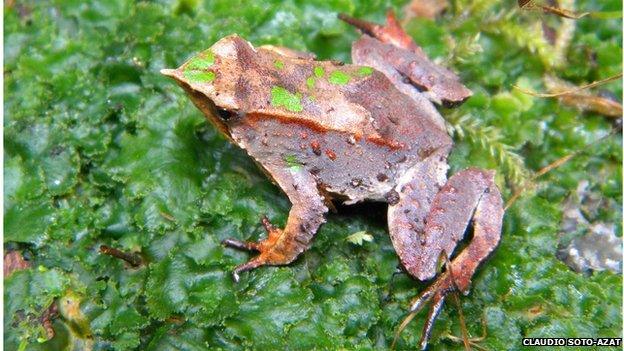Darwin's frogs face fungal assault
- Published

The males of the species incubate fertilised eggs in their mouth
The fungus that is decimating amphibians worldwide has claimed one species of Darwin's frog and may soon claim the other, scientists say.
The animals, so named because of the great naturalist's involvement in their discovery, are distinctive for the males rearing the young in their mouth.
Researchers tell Plos One journal, external that habitat destruction has undoubtedly blighted the South American frogs, but cannot explain the declines in full.
They blame chytrid fungus, also.
The infection, first identified over a decade ago, is now prevalent on every continent, and kills amphibians by blocking the transfer of vital substances through their skins, eventually causing cardiac arrest.
In their Plos One paper, the team review the status of both species of Darwin's frogs - the northern type, Rhinoderma rufum, which has been endemic to Chile, and the southern version, Rhinoderma darwinii, which is found in Chile and Argentina.
The former has not been seen since 1980 and is presumed extinct; the latter is still evident across its range, but its presence is patchy and in sharp decline.
The review acknowledges forest loss to be the key threat but states that this cannot alone account for plummeting numbers. R. darwinii, for example, is declining in some areas where its preferred habitat is not disturbed.
Tests on live and archived samples of the frogs has revealed the presence of Batrachochytrium dendrobatidis, the agent that causes the chytridiomycosis disease. And although the infection rates are not as big as in some amphibian populations, its lethal consequences for the Rhinoderma species cannot be overlooked, the team write.
The Plos research team included scientists from Universidad Andrés Bello (UNAB), Chile, and the Zoological Society of London (ZSL), UK.
"We can't tell conclusively what has been causing the death of these frogs but we are putting together a powerful circumstantial case, and we ought to be extremely concerned," said ZSL's Dr Marcus Rowcliffe.
"It's possible to treat chytrid at an individual level. That's not a large-scale solution, of course, but as part of a captive rearing programme, it could be a very important part of the picture for some of these extremely threatened species."
- Published20 November 2012
- Published12 August 2012
- Published10 April 2012
- Published8 November 2011